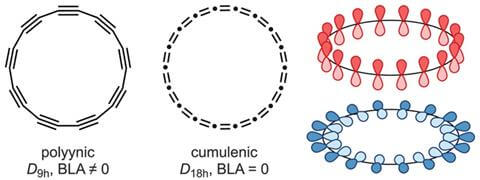New structures of carbon rings raise doubts about the current accepted definition of the concept of aromaticity

[Translation by Dr. Moshe Nachmani]
At first glance, carbon rings (cyclocarbons) look rather boring: rings consisting of only carbon atoms containing alternating double and triple bonds or double bonds only. However, the simplicity of the structure of the rings can be misleading, since until now the preparation of these compounds has been impossible. Only in recent years have chemists managed to stretch the limits of synthesis far enough to gain enough insight into these new molecular structures composed of pure carbon - some of them may change the concept of science regarding the definition of the concept of aromaticity.
The idea of carbon rings as another allotrope of carbon has intrigued chemists for a long time. "Most chemists are attracted to the beauty and symmetry of these rings," said Rik Tykwinski, a chemist working in the field of organic-physical chemistry, a researcher at the University of Alberta, Canada. Already in the 1960s, Nobel laureate in chemistry Roald Hoffmann used carbon rings as a test for his aromaticity calculations. At that time, they were only theoretical molecules, and little was known about their connectivity, geometry, and aromaticity. Predictions regarding these features have often led to professional disputes. "You perform calculations using one method, and the method predicts a certain result, you perform calculations using another method, and the method predicts a different result, or the complete opposite," says the researcher. "Until you actually synthesize the molecule, these questions cannot be answered."

During the 1989s, evidence emerged that carbon rings do exist when they were observed during experiments in the gaseous state. In 18 a research team at the University of California presented for the first time ever the successful synthesis of a ring with 18 carbon atoms (cyclo[30]carbon) in the gaseous state. At this time, the spherical fullerene material was also synthesized for the first time ever and chemists believed that carbon rings could be another stable allotrope of carbon. However, it turned out to be a difficult matter - it would take another 18 years before a scientist at the University of Oxford would succeed in synthesizing a ring with XNUMX carbon atoms in the solid state under conditions that require cryogenic temperatures and the stabilization of the material on a crystalline surface.
Over the past few years, a friendly scientific competition has developed between the two only research teams in the world creating carbon rings, a competition that provides new records in this field. Researcher Wei Xu's group from Tongji University in China now claims the preparation of the smallest carbon ring of 6 carbon atoms, which was reported in a paper recently published in early October 2023. A month later, a research group led by scientist Anderson published a paper about the synthesis of a 13-atom carbon ring Carbon, the first ring of its kind with an odd number of carbon atoms.
Researchers began to uncover unusual aromaticity in some of the carbon coins, a fact that raises doubts about the accuracy of the definition of this term. Although all carbon rings synthesized so far have been formed on surfaces, this year we may see the first structure formed off-surface and even see their applications in the synthesis of innovative carbon-based materials.
At the core of current discoveries are the methods of "controlling a single atom", specifically atomic force as well as scanning tunneling microscopy (STM). At extremely low temperatures, starting compounds are inserted into a metallic single crystal coated with several atomic layers of inert sodium chloride. Pulses of electric current coming from the tip of the microscope (ATM) are used in the next step to convert the starting materials into carbon rings, both with the help of removing chemical converters such as carbon monoxide or chlorine, and with the help of breaking internal chemical bonds. Sophisticated planning was invested in the selection of the starting material - it must be stable enough to withstand the take-off stage that transfers it to the surface, but unstable enough so that it fails to mask the carbon ring following reactions induced by the tip of the microscope. "The synthesis of the starting material, which was a carbon ring with 18 carbon atoms, lasted a whole year," says the researcher. "The starting material was very unstable, so much so that we had to transport it in dry ice and act very quickly from the moment it arrived at the laboratory. And really, I was very skeptical about the phase where we detach the starting material from the surface, a phase where we are required to remove several molecules of carbon dioxide, if it actually occurs as expected. "In our case, the bet was successful and the researchers in my group were indeed able to see the first carbon ring ever formed in the solid state and not in the gaseous state. In the next step, the researchers repeated the experiment dozens of times to make sure that the synthesis was indeed successful.
![The preparation process for 6C – the smallest carbon ring ever reported – is obtained by removing chlorine groups from the starting material bound to the surface [source: Wei Xu et al ©]](https://www.hayadan.org.il/images/content3/2024/01/531606_e6cdf9aeed5a4743b1185f6c3701bb7f13_874069.jpg)
The preparation process of 6C – the smallest carbon ring ever reported – is obtained by removing chlorine groups from the starting material bound to the surface [source: Wei Xu et al ©]
Carbon rings have two pi systems, one in the plane of the ring and another perpendicular to it. "It is possible that both pi systems are aromatic, which is fine," explains the researcher, referring to examples such as a ring with 18 carbon atoms. "It is possible that both pi systems are anti-aromatic, and this is also a well-known situation. This is the case for a ring with 12 carbon atoms. "At the same time, there may be a situation where one of the pi systems is aromatic and the other is anti-aromatic." This is the case for a ring with 16 carbon atoms.

A small change in energy causes an inversion of aromaticity in a 16-carbon ring [Source: © 2023 Igor Rončević et al]
The ground state of the carbon 16 ring is doubly antiaromatic - a problematic state that causes the molecule to be in an extremely distorted structure relative to the normal structure of a planar ring. However, with a slight nudge of added energy, the molecule can go into an excited state where the spin of the electrons is reversed. This situation causes one of the pi systems to become aromatic while the other remains antiaromatic. "One of the pi systems "pushes" the molecule to be symmetrical, round and aromatic, while the other "pushes" it into a distorted structure that leaves its aromatic state," explains the researcher. In this strange and delicately balanced situation, "the concept of aromaticity begins to be a bit flexible, since small changes in structure can change the relative contribution of each of the separate pie systems," explains the researcher. The research team calls this strange situation "mixed" aromaticity, a name that does not do enough justice to how the concept of aromaticity is accepted in our understanding. Small changes in the geometry of the molecule should not drastically change its aromaticity, but for the 16C molecule this is exactly what happened. "This finding causes a revolution regarding the definition of aromaticity," notes the lead researcher.
Researchers agree that there probably won't be any commercial applications for carbon rings anytime soon. At the same time, carbon rings can be used for the preparation of new types of carbon compounds including very large rings. The first hint that such an application might be realistic came from research on the preparation of a 13C ring, which unexpectedly fused with another identical ring to give a ring twice as large as 26C. "We anticipate that carbon rings will be effective starting materials in the future for the preparation of unique two-dimensional carbon materials, such as graphdiyne," says the researcher. This finding, he adds, could be the next great achievement in the field.
Sources:
1. F Diederich et al, Science, 1989, DOI: 10.1126/science.245.4922.1088
2. K Kaiser et al, Science, 2019, DOI: 10.1126/science.aay1914
3. W Xu et al, Res. Sq., 2023, DOI: 10.21203/rs.3.rs-3411973/v1
4. F Albrecht et al, 2023, DOI: 10.26434/chemrxiv-2023-ddrh7
5. Y Gao et al, Nature, 2023, DOI: 10.1038/s41586-023-06566-8
6. I Rončević et al, J. Am. Chem. Soc., 2023, DOI: 10.1021/jacs.3c10207

One response
It would help to explain what aromatic, anti-aromatic and pie are and not throw out terms that most readers don't understand